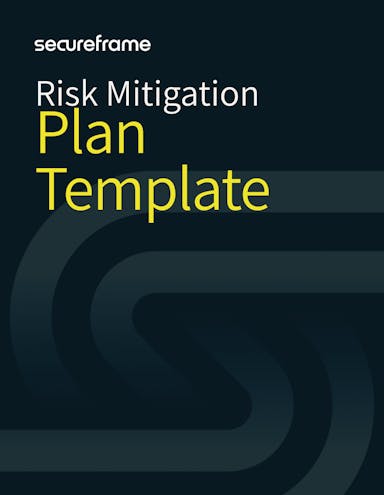
The Future of Risk Management: Embracing Automation for Better Decision-Making
Emily Bonnie
Senior Content Marketing Manager
Rob Gutierrez
Senior Cybersecurity and Compliance Manager, CISA, CCSK, CMMC RP
Organizations are facing complex and cascading risks, from increasingly sophisticated cybersecurity threats and regulatory changes to supply chain disruptions. This rapidly evolving landscape demands a more sophisticated approach to risk management than manual, point-in-time assessments.
By integrating data science, automation, and artificial intelligence, risk management automation is transforming the way risks are identified, assessed, managed, and monitored.
According to PwC’s 2023 US Risk Perspectives Survey, more than half of risk teams say they have seen “significant improvement” in how they manage risks by using applications such as advanced analytics, automated workflow solutions, artificial intelligence/machine learning, and GRC platforms.
In this article, we’ll highlight how organizations can incorporate automation into their risk management program to quickly identify potential risks, strengthen security controls, and improve operational efficiency.
Recommended reading

30+ Risk Management Statistics to Know in 2024
Why manual approaches to risk management are insufficient
Ineffective risk management processes can have severe and far-reaching consequences for an organization, from wasted time and resources to realized threats resulting in financial and reputational losses. Like many other manual business processes, automation is being used to address risk management challenges and improve accuracy, efficiency, and effectiveness.
1. Point-in-time assessments are quickly outdated
One of the significant drawbacks of manual risk management is its reliance on point-in-time assessments. In a rapidly changing business environment, data gathered during manual assessments can quickly become outdated, leading to significant blind spots.
Unlike automated systems, manual processes struggle to provide continuous monitoring and real-time threat intelligence. This limitation hampers an organization’s ability to respond proactively to emerging threats and vulnerabilities. Effective risk mitigation requires tools that offer continuous monitoring and instant updates to ensure that risk management strategies are based on the most current information.
2. Manual processes are time-consuming and resource-intensive
Manual risk management processes require significant time and effort to collect, analyze, and report on risk data. This not only overburdens risk management teams but diverts valuable resources away from other critical activities as well. Inefficiencies also lead to delays in identifying and responding to risks.
3. Fragmented information is spread across siloed departments
Another challenge with manual risk management is the fragmented nature of information spread across different departments and business units. This siloed approach often leads to inconsistencies in risk data, gaps in communication, and an incomplete view of the organization’s risk posture. Without a centralized system for risk data, it becomes challenging to have a comprehensive and cohesive understanding of the risks facing the organization, leading to potential vulnerabilities in the risk management strategy.
4. Increased potential for human error
Risk management involves analyzing large volumes of data, and manual handling of this data increases the likelihood of human error. Overwhelmed with tedious and repetitive tasks, risk teams can become prone to burnout, further increasing the risk of mistakes. These errors can lead to incorrect risk assessments, misguided decision-making, and ultimately, ineffective risk management strategies. The complexity and volume of data in risk management demand precision and accuracy, which can be challenging to achieve consistently through manual processes.

Risk Mitigation Plan Template
Use this template to help set an organizational risk mitigation strategy and align employees and other stakeholders to it, or use it to mitigate risks for specific projects as an individual or group.
What is risk management automation? The benefits for stronger cybersecurity
Risk management automation refers to the use of software tools to automate the processes of identifying, assessing, managing, and monitoring risks within an organization.
These tools can automatically gather information from different sources, figure out which risks are most important, and suggest ways to reduce or handle these risks. Automation solutions can also monitor risks over time and create reports to help businesses avoid disruptions and make informed decisions that reduce risk.
Risk management automation offers a multitude of benefits that can transform the way organizations approach and handle risks.

1. Centralized risk data
Risk management automation tools centralize risk data, providing a comprehensive and accurate view of an organization's risk exposure and mitigation efforts. By integrating with other GRC and vulnerability management systems, these tools offer a single source of truth, ensuring that all risk-related information is consistent and accessible. This centralized approach streamlines risk data management, enhancing visibility into potential vulnerabilities and the effectiveness of risk mitigation strategies.
2. Real-time risk assessments
Unlike point-in-time risk assessments that rely on manual processes, automation tools offer continuous, real-time risk assessments. This allows organizations to be more proactive and responsive to both emerging risks and new opportunities. With the dynamic nature of business environments, real-time assessments enable organizations to quickly identify and respond to changes, ensuring that they stay ahead of potential threats.
3. Enhanced analysis and reporting
Risk management automation tools possess advanced data analysis capabilities. They can sift through vast amounts of data to identify trends and generate real-time insights, enhancing strategic decision-making. These tools also facilitate comprehensive reporting on risk management efforts and improvements, supporting informed decision-making and demonstrating the value of risk management activities to key stakeholders.
4. Continuous monitoring against threats and issues
Automated risk management tools continuously monitor risk indicators, alerting teams to potential threats and issues as they arise. This ongoing vigilance is crucial in fast-paced environments where threats can emerge rapidly and unexpectedly. Continuous monitoring ensures that organizations can quickly detect and respond to risks, minimizing their impact.
5. Streamlined workflows
Automation streamlines and standardizes risk management processes, reducing human error and boosting operational efficiency. By automating routine tasks, teams can focus on high-priority actions that require human intelligence and judgment. This not only enhances the effectiveness of risk mitigation strategies but also allows risk management teams to concentrate on more complex and value-adding activities.
6. Operational and cost efficiency
Centralizing risk, security, and compliance data in a single tool enhances operational and cost efficiency. This unified approach simplifies the analysis, tracking, and communication of tasks involved in assessing and managing risk and demonstrating compliance. Teams become more effective and efficient, reducing the time and resources spent on managing disparate systems and processes.
7. Scalability
As organizations grow, their risk management needs become more complex. Automation tools are designed to store and analyze large volumes of data, enabling organizations to scale their risk management processes effectively. This scalability ensures that as a business grows, its risk management framework can effectively adapt and grow in tandem.
8. Easier regulatory and compliance reporting
Automated tools significantly reduce the time and effort involved in regulatory and compliance reporting. They collect data and generate regular compliance reports, avoiding penalties for non-compliance. Since most security frameworks, including SOC 2, ISO 27001, and NIST 800-53 require regular risk assessments, an automated tool that can easily conduct risk assessments and generate reports streamlines routine audit and compliance tasks.
Recommended reading

4 Ways Cybersecurity Leaders Can Prepare for 2024
How does risk management automation work?
While the features and capabilities of risk management automation vary, here's how these tools typically work:
- Data collection: First, the automation tool gathers data from various sources such as financial reports, operational data, market trends, and external sources like news feeds or industry reports. Automation tools integrate this data to provide a comprehensive view of potential risks.
- Risk identification and analysis: Using algorithms and machine learning, automation tools analyze this data to detect patterns, trends, and anomalies to understand the organization’s risk landscape and identify potential risks. For example, a sudden change in market conditions or a spike in negative social media mentions could be flagged as potential risks.
- Risk assessment and prioritization: After identifying risks, the tool assesses their potential likelihood and impact, which can include calculating potential financial impact. After quantifying risks, the tool can prioritize them based on severity.
- Risk mitigation and treatment strategies: Based on the risk assessment, the tool may suggest or automate certain remediation strategies such as adjusting financial portfolios, changing operational processes, or implementing new security controls.
- Risk monitoring and reporting: Continuous monitoring is crucial in risk management. Automated tools keep track of the identified risks and the effectiveness of mitigation strategies. They provide real-time alerts and reports, helping organizations respond to changing risk landscapes.
- Compliance and regulatory reporting: Many risk management automation tools also assist in ensuring compliance with various regulatory standards. They can automatically generate reports and track changes in regulations to ensure continuous compliance. They can also ensure that you’re including certain types of risk that may be specifically required for certain frameworks, such as fraud risks for SOC 2, supply chain risks for NIST 800-53, or third-party risks for CIS.
- Dashboards and data visualization: To make information more accessible and actionable across the organization, risk management automation tools often include visual reporting and tracking tools like dashboards. This allows CROs, CISOs, and other key decision-makers to quickly understand the risk landscape and make informed decisions.

Automate your risk management processes with Secureframe
Our end-to-end risk management solution makes it easy to identify, manage, and mitigate risk so you can build and maintain a strong security posture.
Automate risk assessments
Secureframe’s automated risk assessment tools save time and reduce the costs of maintaining a strong risk management program.
This automated approach is faster and more consistent than manual risk assessment methodologies and gives risk management teams a more comprehensive view of their organization’s risk profile. This is especially valuable for organizations with a rapidly changing threat landscape or where large amounts of data need to be analyzed quickly, such as cybersecurity risk, financial risk, and environmental risk.
Comply AI for Risk is an AI-powered tool that leverages risk descriptions and company information to produce detailed insights into risks, including suggested risk scores, risk treatment plans, and the likelihood and impact of risks before and after response.
Automate vendor risk management
Secureframe assesses the risk level for each vendor based on the sensitivity of data they can access and their importance to your business processes. The automation platform provides risk recommendations and enables the continuous monitoring and tracking of your vendors' security posture. This ensures you have the latest information about your vendors' risk posture and compliance with regulatory and industry requirements.
Leverage AI for risk analysis and treatment
Comply AI for Risk accelerates risk assessments with an automated workflow. AI generates an inherent risk score, treatment plan, and residual risk score so organizations can improve their risk awareness and response. The tool also offers tailored remediation guidance to quickly deploy fixes to your cloud environment and eliminate vulnerabilities.
Continuously monitor your risk management program
Secureframe provides a risk library that includes risk scenarios for categories like Fraud, Legal, Finance, and IT. Organizations can easily add, edit, and track these risks in their risk register, and view risk histories to demonstrate the impact of your mitigation strategies.
Dashboards provide a comprehensive view of your organization's risks, allowing you to visually monitor your progress over time and effectively communicate the health of your risk management program to executives, auditors, and other stakeholders.
To get started automating your risk management, schedule a personalized demo with a Secureframe product expert.
Use trust to accelerate growth
FAQs
What is automation in risk management?
Automation in risk management refers to the use of technology, particularly software tools and applications, to streamline and enhance the process of identifying, assessing, managing, and monitoring risks in an organization. This includes tasks such as data collection, risk analysis, risk prioritization, and reporting. The goal of automation in risk management is to optimize efficiency, accuracy, and consistency, reduce the likelihood of human error, and enable a more proactive approach to managing cyber risks.
Can risk assessments be automated?
Yes, risk assessments can be automated. Automation tools can collect and analyze data from various sources to identify potential risks. These tools use algorithms, machine learning, and sometimes artificial intelligence to assess the likelihood and potential impact of these risks. Automated risk assessments help in prioritizing risks and often provide recommendations for mitigation strategies. This automation not only speeds up the risk assessment process but also brings in a level of consistency and objectivity that might be challenging to achieve manually.
What is RPA in risk management?
RPA, or Robotic Process Automation, refers to software robots or 'bots' that automate the repetitive and rule-based tasks that are part of the risk management process. This can include data entry, generating reports, monitoring compliance standards, and even conducting initial risk assessments. RPA helps reduce the time and effort spent on routine tasks, allows human resources to focus on more complex risk analysis, and improves the overall efficiency and accuracy of the risk management process.
Does automation reduce risk?
Automation can significantly reduce certain types of risks, especially those related to human error, inefficiencies, and inconsistencies in data handling and processing. For example, automated systems can consistently apply rules and procedures, ensuring compliance and reducing the risk of breaches due to oversight or mistakes. However, it's important to note that automation also introduces new risks, such as system failures or cybersecurity vulnerabilities. While automation can reduce some risks, it must be implemented thoughtfully and be accompanied by measures to manage and mitigate any new risks it introduces.

Emily Bonnie
Senior Content Marketing Manager
Emily Bonnie is a seasoned digital marketing strategist with over ten years of experience creating content that attracts, engages, and converts for leading SaaS companies. At Secureframe, she helps demystify complex governance, risk, and compliance (GRC) topics, turning technical frameworks and regulations into accessible, actionable guidance. Her work aims to empower organizations of all sizes to strengthen their security posture, streamline compliance, and build lasting trust with customers.

Rob Gutierrez
Senior Cybersecurity and Compliance Manager, CISA, CCSK, CMMC RP
Rob Gutierrez is an information security leader with nearly a decade of experience in GRC, IT audit, cybersecurity, FedRAMP, cloud, and supply chain assessments. As a former auditor and security consultant, Rob performed and managed CMMC, FedRAMP, FISMA, and other security and regulatory audits. At Secureframe, he’s helped hundreds of customers achieve compliance with federal and commercial frameworks, including NIST 800-171, NIST 800-53, FedRAMP, CMMC, SOC 2, and ISO 27001.